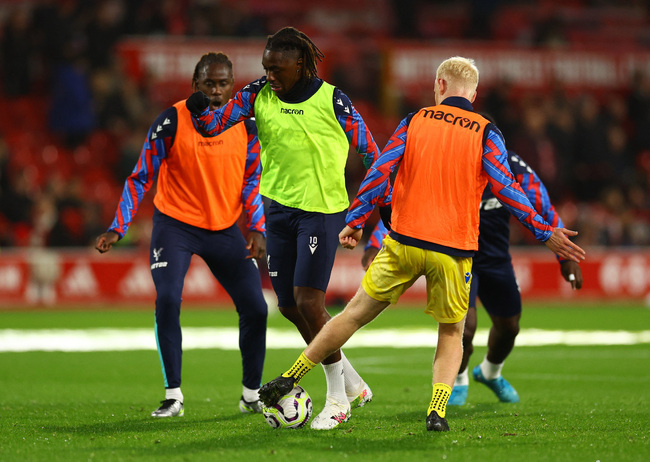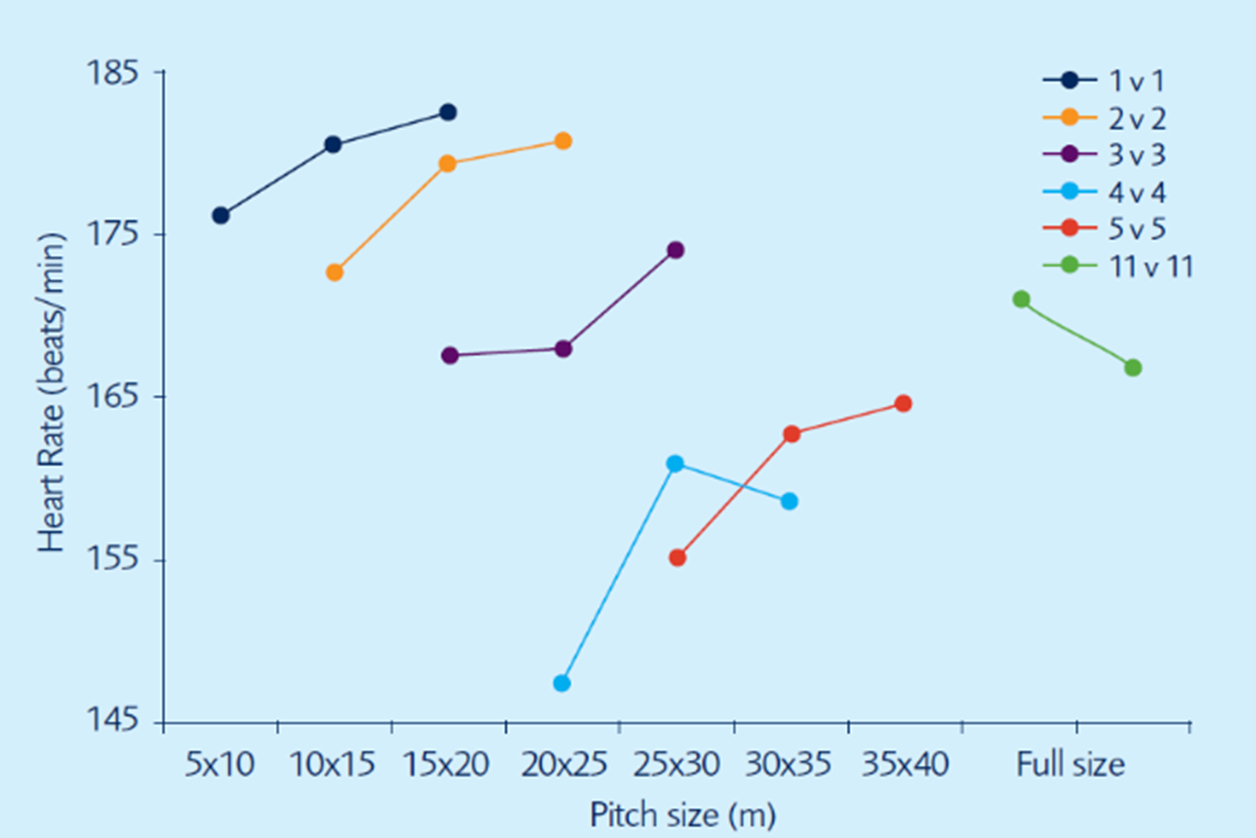You are viewing 1 of your 1 free articles
RTS: Football Conditioning Games
Football conditioning games restore physical, technical, and cognitive capacities following injury. Understanding how and when to implement them is critical for clinicians working with this cohort. Joshua Smith delves into the methodology of effectively introducing conditioning games into return to sport pathways.
Soccer Football - Premier League - Nottingham Forest v Crystal Palace - Crystal Palace’s Eberechi Eze during the warm-up before the match Action Images via Reuters/Andrew Boyers
Soccer teams must regularly deal with 50 time-loss injuries per season, which averages out to two injuries per player in a squad of 25. This significantly impacts the team’s performance, as up to 14% of the squad is unavailable due to injury(1). These performance-related consequences also carry financial implications. For example, in the English Premier League, teams lose an average of £45 million due to time-loss injuries suffered over the course of a season(2). Considering this, clinicians and researchers continue to uncover strategies to mitigate injury risks, improve injury prevention, and refine return to sport protocols.
The return to play phase marks the final step in a player’s rehabilitation, with training load monitoring becoming incredibly important to minimize the re-injury risk while at the same time bringing the player to their pre-injury physical level(3). Part of the return to play process includes the gradual re-introduction to contact-based drills, which in the case of football are small-, medium-, and large-sided games (see table 1). Practitioners refer to these terms collectively as football conditioning games.
Table 1: Football conditioning games and player numbers
| Game name | Player numbers |
| Small Sided Games | 3v3 - 4v4 |
| Medium Sided Games | 5v5 - 8v8 |
| Large Sided Games | 9v9 - 11v11 |
Football Conditioning Games
Modern football demands continue to shift, and practitioners use small-, medium-, and large-sided games to develop players’ technical and tactical acumen and physical capacity. Football conditioning games are valid and representative of the real-world physical, technical, and tactical requirements of football match play and are the foundation of football training methodologies globally(4–7).
Table 2: Advantages & disadvantages between specific & generic conditioning(8).
| Soccer drills | Traditional running |
| Football conditioning games with specific constraints. | A controlled running session with players exercising for a specific time and distance. |
| Advantages | |
| Improved motivation. | Exact work intensity - easily monitored. |
| Enhanced training in movement efficiency. | Improvements can be monitored objectively. |
| Improvements in tactical awareness. | Comparisons can be made between players. |
| Improvements in technical skills. | Gain insights into player character/motivation. |
| Optimizes training time and physical load. | |
| Potential decrease in injuries. | |
| Disadvantages | |
| Exact work intensity is difficult to control. | Less movement associated with match play. |
| It is often difficult to organize an optimal training structure. | Players do not practice technical skills. |
| Increased risk of contact injuries. | No game based tactical elements. |
| Need numbers to make up session. | Players do not like running. |
| Certain degree of technical ability required. | May increase injury risk due to unaccustomed training. |
| Possible ceiling effect for very fit players. | |
While the use of these games aligns itself with the principle of specificity, there are instances where the intensity of the games cannot be as precisely controlled as generic physical conditioning (see table 2). Because of this, all practitioners need to note that several variables can be manipulated to regulate the physical and physiological demands associated with these games, which in turn will allow for a more precise training load planning and, ultimately, a reduction in re-injury risk that may be associated with exposing a returning player to the incorrect game format and variables that they are not prepared for. Practitioners must consider the player numbers, duration of games, pitch size, and rules utilized as they influence the intensity of football conditioning games(7,9,10).
Player numbers
A different training response is elicited based on the game size(8,11). The lower the player numbers, the higher the intensity, whereas most of the physical indicators increase as the number of players increases, i.e., peak speed and acceleration(5,8,10).
Game duration
Repetition duration, repetition count, and the work-to-rest (W:R) ratio contribute to the induced stress during football conditioning games(12–14).Manipulating these three components, which suit specific training categories, elicits different training intensities and training responses (see table 3).
Table 3: Training load categories(14,15).
| Training type | Training intensity |
| Lactate threshold | 80-90% heart rate max |
| VO2 max | 90-95% heart rate max |
| Anaerobic | >85% heart rate max |
Pitch size
When the player number is kept constant, altering the pitch size can elicit different physiological responses (see figure 1)(16).
Rules utilized
By manipulating the rules, practitioners will impact the physical stress imposed on the athletes. For example, restrictions on the number of ball contacts allowed per player at a time – one-touch, two-touch, and free-play.
Game format
Adjusting the game format creates different technical, tactical, and cognitive stressors for athletes. For example, using normal goals with goalkeepers, possession-based games, or small goals without goalkeepers. All these formats play a role in the return to sport pathway, and clinicians must consider the adjustments necessary to meet the player’s recovery stage and induce cognitive and physical stressors necessary to allow adaptation. Furthermore, coaches can use verbal encouragement/information, which may include tactical and technical ques and general encouragement to maintain a high work intensity(14,15). Considering that these variables have been identified as impacting the intensity of football conditioning games, it’s important to unpack them into two specific categories: internal and external loading.
“A different training response is elicited based on the game size.”
Internal and External Load
When planning their return to sports protocols, clinicians can use heart rate response (% of maximal heart rate) to design and target specific physiological capacities. For example, 3v3-4v4 FCGs develop VO2 max, while 5v5, 6v6, 8v8, and 9v9 develop lactate thresholds. Furthermore, 3v3 improves repeated sprint ability, and finally, 1v1 and 2v2 develop speed endurance production and speed endurance maintenance, respectively(5,8,10,15–29). They must apply specific pitch sizes, rules, and work-to-rest ratios for these conditioning games to achieve the required intensities associated with lactate threshold, VO2 max, and anaerobic training (see table 4).
Table 4: Football conditioning games and variables for specific training goals.
| Maximal aerobic sided game (MASG) | |||||||
| Player number | Pitch size | Game duration | Variables | ||||
| Repetition count | Repetition duration | W:R | Variable 1 | Variable 2 | Variable 3 | ||
| 3v3 |
25x15m, 36x27m, 39x22m |
4 - 10 | 4 minutes | 1:1 and 1:0.5 | Coach encouragement | Possession | Two-touch |
| 4v4 |
30x20m, 36x27m, 40x30m |
4 - 10 | 4 minutes | 1:1 and 1:0.5 | Coach encourage | Possession | Two-touch |
| Lactate threshold sided game (LTSG) | |||||||
| Player number | Pitch size | Game duration | Variables | ||||
| Repetition count | Repetition duration | W:R | Variable 1 | Variable 2 | Variable 3 | ||
| 5v5, 6v6, 8v8, 9v9 |
45x27m, 50x27m, 55x36m, 60x50m, 94x41 |
3 - 4 | 5-10 minutes | :0.2 | Coach encouragement | Goalkeepers | Free play |
| Repeated sprint ability sided game (RSASG) | |||||||
| Player number | Pitch size | Game duration | Variables | ||||
| Repetition count | Repetition duration | W:R | Variable 1 | Variable 2 | Variable 3 | ||
| 3v3 |
30x25m |
5 - 11 | 3 minutes | 1:0.6 | Coach encouragement | Goalkeepers | Two-touch |
| Speed endurance sided game (SESG) | |||||||
| Player number | Pitch size | Game duration | Variables | ||||
| Repetition count | Repetition duration | W:R | Variable 1 | Variable 2 | Variable 3 | ||
| 1v1 (Speed endurance production) | 25x15m | 4 - 12 | 20-40 seconds | 1:4 | Coach encouragement | Possession | One and Two-touch |
| 2v2 (Speed endurance maintenance) | 25x15m | 3 - 12 | 30 - 90 seconds | 1:3 | Coach encouragement | Possession | One and Two-touch |
When considering the external load (such as total distance run, high-speed distances, absolute maximum velocity, etc.), all these metrics increase with an increase in pitch size and player number utilized (10v10, > 7v7, > 5v5). Furthermore, total distance, very high and maximal speed distances increase when the game format includes goalkeepers (versus possession), while accelerations and decelerations increase in smaller-sided formats (5v5 > 7v7 > 10v10)(30).
"…each format exposes players to different external and internal loads…"
What and When?
When considering the influence of FCGs in return to play, clinicians must consider the individual athlete’s needs based on their level of play, goals, and injury. What is important to note is that when planning a player’s return to play, practitioners must understand the implications of involving a player in a 3v3 versus an 8v8 and how each format, with differing variables being used, will result in differing training stimuli, both internally and externally (see figure 2).
Anecdotally, players are often reintroduced to training sessions based on sprinting and completing change-of-direction actions pain-free. However, these are done in isolation. Practitioners need to factor in the demands of each differing format and the impact this may have on a player. Linked to this, practitioners need to have open and clear lines of communication with the Head Coach, Assistant Coach, and conditioning staff, as the session plan (which games will be used) will impact the player. It may very well be the case of a player completing a warm-up and technical-tactical work before coming out of the session because the football conditioning game at the end of training would result in the player being exposed to loading that is not appropriate.
Conclusion
The role of football conditioning games in football training is incredibly important, as they allow coaches to address technical, tactical, physical, and psychological components of their playing style and system. However, as each format exposes players to different external and internal loads, it is vital that the return to play phase is planned clearly in terms of doses and monitored thoroughly to reduce any re-injury risk.
References
1. Br J Sports Med. 2013 Aug;47(12):723–4.
2. BMJ Open Sport & Exercise Medicine. 2020;6(e000675).
3. AIMSPH. 2024;11(1):315–29.
4. J Hum Kinet. 2012 Jun;33:103–13.
5. J Strength Cond Res. 2013 May;27(5):1295–303.
6. J Strength Cond Res. 2014 Nov;28(11):3121–7.
7. Science & Sports. 2016 Oct;31(5):e155–61.
8. J Strength Cond Res. 2009 Jun;31(3):67–74.
9. Sports Medicine. 2011 Mar;41(3):199–220.
10. J Strength Cond Res. 2013 May;27(5):1287–94.
11. Int J Sports Med. 2014;35(04):286–92.
12. Brooks GA, Fahey TD, Baldwin KM. Exercise physiology: human bioenergetics and its applications. 4th ed. Boston: McGraw-Hill; 2005. 876 p.
13. Sports Medicine. 2004;34(3):165–80.
14. Owen A, Dellal A. Football Conditioning A Modern Scientific Approach: Periodization - Seasonal Training - Small Sided Gam. SoccerTutor.com; 2016.
15. Strudwick T, Walker G. ‘Conditioning Progammes for competitive levels’, in Strudwick, T. (ed.) Soccer Science. In Champaign, IL: Human Kinetics; 2016.
16. OR Insight. 2004;7(2):50–3.
17. J Strength Cond Res. 2006;20(2):316.
18. J of Strength Cond Res. 2011 Sep;25(9):2371–81.
19. J of Sports Sci. 2007 Apr;25(6):659–66.
20. J Sports Med Phys Fitness. 2008 Jun;48(2):166–71.
21. J Strength Cond Res. 2011 Aug;25(8):2104–10.
22. J Strength Cond Res. 2007;21(2):367.
23. J of Strength Cond Res. 2012 Oct;26(10):2890–906.
24. Br J of Sports Med. 2002 Jun 1;36(3):218–21.
25. J of Sci and Med in Sport. 2009 Jul;12(4):475–9.
26. Medicine and Science in Sports and Exercise. 2001 Nov;33(11):1925–31.
27. Owen A, Dellal A. Football Conditioning A Modern Scientific Approach: Fitness Training - Speed & Agility - Injury Prevention. SoccerTutor.com; 2016.
28. Dawes J, Roozen M, National Strength & Conditioning Association, editors. Developing agility and quickness. Champaign, IL windsor, ON Leeds Lower Mitcham: Human Kinetics; 2012. 186 p. (Sport performance series).
29. J Strength Cond Res. 2011 May;25(5):1285–92.
30. Human Movement Science. 2014 Aug;36:123–33.
Newsletter Sign Up
Subscriber Testimonials
Dr. Alexandra Fandetti-Robin, Back & Body Chiropractic
Elspeth Cowell MSCh DpodM SRCh HCPC reg
William Hunter, Nuffield Health
Newsletter Sign Up
Coaches Testimonials
Dr. Alexandra Fandetti-Robin, Back & Body Chiropractic
Elspeth Cowell MSCh DpodM SRCh HCPC reg
William Hunter, Nuffield Health
Be at the leading edge of sports injury management
Our international team of qualified experts (see above) spend hours poring over scores of technical journals and medical papers that even the most interested professionals don't have time to read.
For 17 years, we've helped hard-working physiotherapists and sports professionals like you, overwhelmed by the vast amount of new research, bring science to their treatment. Sports Injury Bulletin is the ideal resource for practitioners too busy to cull through all the monthly journals to find meaningful and applicable studies.
*includes 3 coaching manuals
Get Inspired
All the latest techniques and approaches
Sports Injury Bulletin brings together a worldwide panel of experts – including physiotherapists, doctors, researchers and sports scientists. Together we deliver everything you need to help your clients avoid – or recover as quickly as possible from – injuries.
We strip away the scientific jargon and deliver you easy-to-follow training exercises, nutrition tips, psychological strategies and recovery programmes and exercises in plain English.









